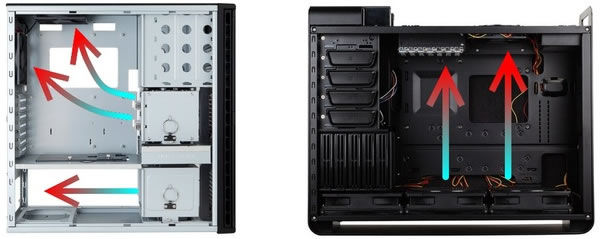We've seen an influx of desktop computer cases that claim to offer superior cooling by rotating the system's internals and embracing the natural occurrence of convection. Silverstone's Raven series immediately comes to mind as we've reviewed two of them this year. Although we can personally attest to the Raven's incredible cooling capacity, how much of it is attributed to the vertical orientation? That's precisely what Puget Systems has attempted to answer.
The company examined the thermal dissipation of two popular chassis: the Antec P183 V3 with a conventional horizontal arrangement and the Silverstone FT02B-W with its newfangled vertical voodoo. To be clear, Puget didn't pit the enclosures against one another, but they physically rotated each case to record temperature differences between horizontal and vertical orientations. Both were outfitted with top-end hardware and a couple different cooling solutions.
The conclusion? Flipping your hardware by 90 degrees offers no discernable thermal advantage. Two of the four tests resulted in a tie, one gave a minor edge to the vertical orientation and another favored the horizontal configuration by a few degrees. Puget found that convection plays a minimal role (if any) in desktop cooling because even the weakest fans impose far more force on a case's hot air than its natural buoyancy. There's a full equation here.

Again, that's not to say Silverstone's cases aren't damn good at cooling hardware. Quite the contrary. While convection can likely be dismissed as a marketing gimmick, Puget noted that the Silverstone's peculiar layout has an advantage in the sense that it adds minimal resistance between the intake and exhaust fans. The airflow doesn't have to cut through as many components (namely a stack of 3.5-inch drives) and the overall travel distance is reduced.
Additionally, there's simply more room for fans in the bottom of a chassis than the front. Vertical cases such as the FT02B-W can accommodate two or three intake fans measuring 180mm or larger, versus one or two 120mm fans or smaller. Before you purchase a Silverstone enclosure, Puget highlighted some potential disadvantages for vertical cases: they're dust magnets, and they're more prone to compatibility issues than their horizontal counterparts.
"Some components may not fit properly because most manufactures design for traditional oriented cases. For example, a long 5.25" device may not fit in the Silverstone FT02B-W as it may come into contact with a PCI card that is installed in one of the lower PCI slots," the company explained. As a footnote, we should mention that we're on the brink of publishing a review of Silverstone's latest addition to the Fortress chassis series, the FT03.
https://www.techspot.com/news/45033-puget-dissects-vertical-vs-horizontal-chassis-cooling.html